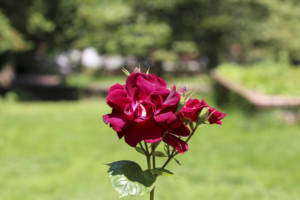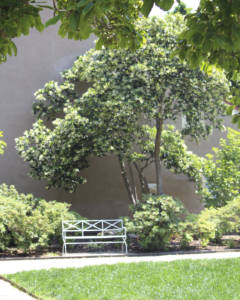
Celebrate The Fourth of July at These Philadelphia Independence Gardens
Located throughout Philadelphia’s historic Society Hill neighborhood are four secret gardens that bring America’s earliest origins to life, in both literal and abstract ways. The gardens are a part of Independence National Historical Park, which protects 50-acres (or about 20 city blocks) of America’s seminal sites. While the larger attractions like Liberty Bell and Independence Hall are clearly marked (if by nothing else, than by the long lines and circling tour buses) many equally-patriotic gardens can be found tucked away between rows of houses, emerging to delight passersby on quiet, seemingly inconspicuous streets.
The gardens are off the beaten path of the typical Philadelphia walking tour, but undoubtedly add a unique perspective to Independence Day celebrations, capturing the country’s early history through plants and design. If you’re looking to infuse some history into a minimally-planned, family-friendly day trip from NYC, then hop on the bus, pick up a picnic from the Reading Terminal (we recommend swinging by Nanee’s Kitchen, which has vegan and gluten-free options), and trace your way back to where United States’ earliest gardens began.
The Rose Garden
The Rose Garden (located between 4th and 5th, with entrances on Walnut St. and Locust St.) is the busiest and largest of the four. Donated by the Daughters of the American Revolution in May 1971, to honor the signers of the Declaration of Independence, the garden grows several antique varieties of roses and displays a path of cobblestones, preserved since 1796. Despite being a small city park, bounded closely by sidewalks and streets, the garden grows 96 different types of roses.
The Magnolia Garden
Just across the street from the Rose Garden, the Magnolia Garden (entrance on Locust St. between 4th and 5th) is the quietest and emptiest, with a high gate obscuring it from foot traffic. Though the magnolias are typically in full bloom during the early spring, the garden is still a beautiful, serene retreat at any time of the year, with a large fountain at the back and the welcome shade of the 13 magnolia trees (one for each of the original 13 colonies) along the perimeter. Inspired by George Washington’s professed interest in magnolias, the Garden Club of America donated the garden in 1959.
The 18th-Century Garden
A more faithful historic representation of early America finds itself in the 18th Century Garden (entrance on Walnut St. between 3rd and 4th), located near to the Dolley Todd House. With its methodical flower beds, orderly column of fruit trees, and long, neat pergola, the garden is an authentic recreation of an 18th-century formal English garden, with all of the plants consistent with what would have been grown in Philadelphia before 1800.
The Benjamin Rush Garden
Located on a busier city corner (at 3rd and Walnut St.), the Benjamin Rush Garden— sometimes called the Bishop William White Garden because of its proximity to the latter’s home– also demonstrates the principles of a traditional 18th-century garden, with symmetrical paths and stout boxwood hedges. Rush was a signer of the Declaration of Independence and the garden is located where his home once stood.
For more information on Independence National Historical Park, visit the National Park Service website.





































